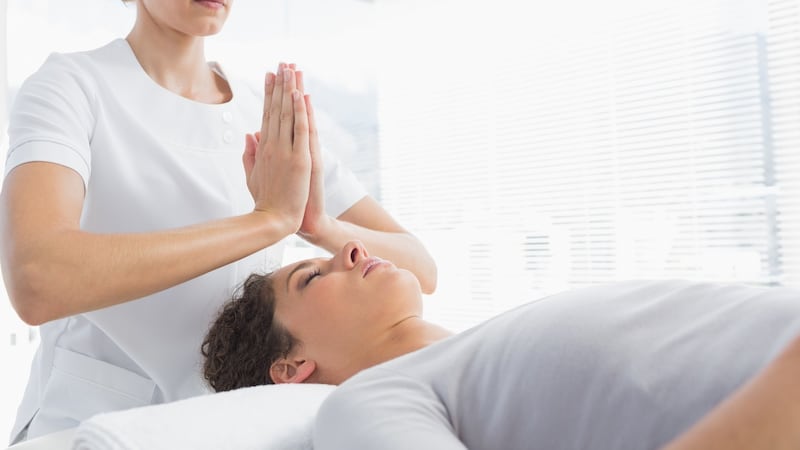What is it?
Reiki is a Japanese word made from the terms meaning “soul, spirit” and “energy, life force”. It is a form of alternative healing based on the belief that there is an energy field surrounding our bodies. Disease arises when this energy is blocked or imbalanced, and manipulation of the field by a reiki practitioner can restore wellbeing. The practitioner does not use his or her personal energy for this but rather channels universal energy to re-energise the field around the patient.
Reiki appears to be of ancient origin and was present in Japan in many forms, although the most common form used in the West is Usui Reiki, which was developed in the 19th century by Mikao Usui. It is written in his headstone that Usui had a spiritual experience after several days of fasting and meditation at the top of a mountain, where he acquired the ability to heal using reiki. He taught his system to a number of students, who in turn taught it to others, thereby establishing a lineage which is ultimately connected to Usui. As well as developing reiki techniques, he also established the concept of attunement, where a reiki master transfers reiki healing to a student, connecting him to the source of universal energy and allowing him or her to use it.

Healing alone is not the sole aim of reiki practicing, as it is associated with spiritual development and personal growth. As such, the practice of reiki is also recommended to healthy people, as a way to maintain their health.
In spite of its association with healing, the Reiki Federation Ireland website states that reiki does not cure ailments. Reiki is thus considered a complementary therapy rather than an alternative to conventional medicine.
Reiki practitioners believe anybody can learn to heal using reiki and courses abound, some of which take place over a weekend. The UK Reiki Federation recommends that courses be at least 9 months in length, although it puts the onus on the student to check that courses and their contents meet their recommendations. Different levels of reiki exist, which relate to the practitioners’ proficiency: there is a level 1, a level 2 and a reiki Master level.
As with the concept of Qi in traditional Chinese medicine, there is no scientific evidence for the existence of an energy field around our bodies. However, touch and massage can have beneficial effects on wellbeing; a particularly effective form of this intervention is skin-to-skin contact, which helps premature babies to thrive.
Is it safe?
There have been no adverse effects reported following reiki treatment, making it extremely safe; in fact, most patients reported feelings of relaxation and well-being following the practice.
What does the evidence say?
A systematic review on the effects of reiki was carried out in 2009, incorporating twelve clinical trials carried out on different conditions including stroke, depression and stress, Alzheimer’s disease and cancer-associated pain, among others. Nine out of the twelve trials showed beneficial effects of reiki for the conditions tested, but eleven out of the twelve clinical trials were assessed as being of poor quality. In fact, quality analysis found that all of the twelve trials were missing key information regarding how strict were the conditions in which they had been carried out. This makes it impossible to establish whether reiki was actually beneficial for these patients or not, as the evidence is of poor quality. A similar analysis carried out the previous year with similar results came to the same conclusion.
A review of three trials totalling around 130 patients suffering from anxiety and depression also found that the trials were lacking in quality. The analysis suggested positive effects of reiki but highlighted that the participating patients had not received clinical diagnosis of anxiety or depression, so it was unclear whether the patients had the conditions to begin with.
A meta-analysis of combined numerical data from four different trials involving 212 patients was carried out to investigate the effects of reiki on pain. Although the study concluded that reiki has a beneficial effect on pain judging by the statistical results, a group of researchers pointed out that the results as shown in the analysis had been misinterpreted by the author and instead pointed to a lack of quantifiable effect.
Two clinical trials, one on painful diabetic nephropathy (207 patients) and one on wellbeing following chemotherapy treatment (189 patients), analysed the effects of conventional care alone or plus reiki; a third group of patients received conventional care plus sham reiki, in which patients received non-reiki touch. In both clinical trials pain and wellbeing were improved for both reiki groups, true and mimic, suggesting that touch and/or general support from healthcare providers are important for these patients and can have direct beneficial effects.
This finding is supported by the apparent lack of effectiveness of distant reiki - in which the practitioner acts remotely and there is no direct physical contact between the practitioner and the patients - in two different clinical trials evaluating effect of reiki on fibromyalgia (100 patients) and pain post-caesarean section (183 patients).
Conclusion
The evidence gathered so far shows that reiki is not more effective than non-reiki touch, with both providing feelings of relaxation and wellbeing that might be helpful in some conditions. The practice of reiki is very safe, with no adverse effects arising from the treatment, and will not interfere with conventional medicine.
Alternative therapies
- What the evidence says
- Acupuncture
- Chiropractic
- Homeopathy
- Reiki
- Aromatherapy
- Why people use alternative therapies











